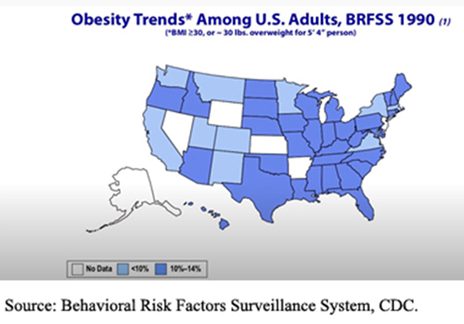Baby Boomers represent the generation born between 1946 and 1964. As a member of this generation, I can recall the popular press touting that we would be the longest living and healthiest generation of all time. Modern medicine and ample food supplies would assure us a long, happy, healthy life. Big problems began as the Boomers reached middle age; it was clear that something was very wrong. Medical issues in aging adults of this generation were growing at alarming rates, but no one was sure of the cause.
We now know that many of the health problems for this generation are directly related to obesity and other unhealthy lifestyles. In a well-intended move, the government decided to get involved. For the first time, Washington told us how and what to eat. In 1980, the government published the Dietary Guidelines for Americans. These Guidelines become the basis for Federal food and nutrition guidance.

Then, with the passage of the 1990 National Nutrition Monitoring and Related Research Act, the 1995 edition of Nutrition and Your Health: Dietary Guidelines for Americans became the first Dietary Guidelines Congressionally mandated by statute.
The problem was the low fat, high carbohydrate diets they supported in the 1980s and 1990s did not work.
They were one of the primary drivers for many of our modern obesity and health problems. This is in fact, a grand experiment gone terribly wrong. And today we are paying the price for this failed experiment. We are paying for it with high blood pressure, stroke, heart attack, Type 2 diabetes, Kidney disease, fatty liver disease, some types of cancer, and other inflammatory disorders.
In the 1960s and 1970s, only 13 percent of U.S. adults were obese; by the 1990s, it was 15%. Today, 32 percent of adult males and 36 percent of adult females are obese. Obesity has become an epidemic more destructive than any other health problem in modern times.
When comparing the obesity rates from 1990 to today, the rate of increase is staggering. In 1990 the most obese state had a rate of obesity less than 15%. Today the lowest rate of obesity in any state is above 20%, and in many states, it is as high as 35%.

https://www.cdc.gov/obesity/data/prevalence-maps.html
This information is of vital importance to today’s generation. It should be a clear warning that controlling weight gain is one of the most important behaviors you need to stay healthy.
Food for Thought – Food additives. Nonfood chemicals and compounds are added to processed foods to improve their shelf life, color, taste, and texture. These additives can cause allergic reactions in sensitive people and can lead to many serious health problems. It is best to limit processed foods in favor of whole foods whenever possible.
Trouble Shooting Your Fast – You may hear people say if I don’t eat, I will immediately go into starvation mode. The truth is that it takes at least 72 hours to get close to starvation mode. Then you have another three weeks before any serious problems begin.
To sign up for my free weekly blog, scroll to the bottom of this page and use the “Have Questions?” section to subscribe; fill in your name, email address, and the word “Blog,” and I will sign you up. You will have the option of canceling any time you wish.



